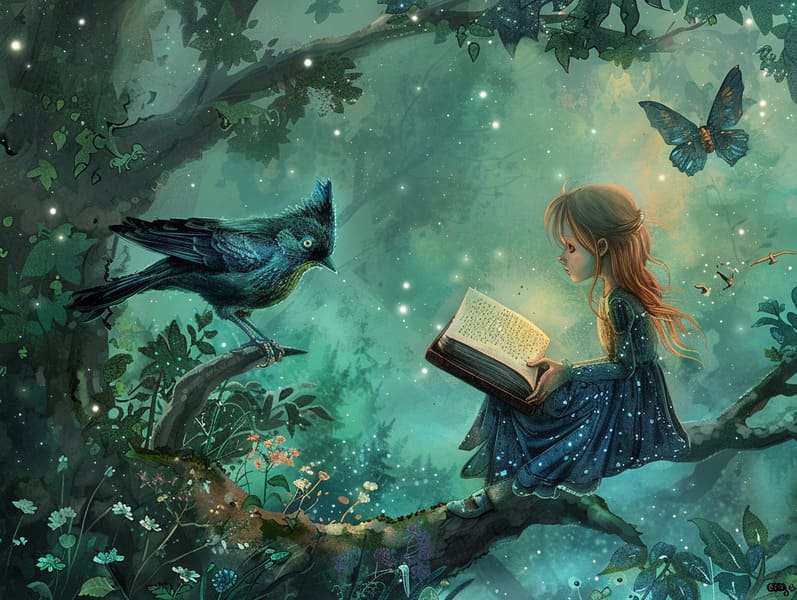
Historical fairy tales have legendary status. These stories have been shared from one generation to the next ages before they were ever published. They were born from a variety of cultures, including Asian traditions. They were initially told among elders, often carrying themes and messages pertaining to the societal norms and beliefs of the time.
The Brothers Grimm, Jacob and Wilhelm (the Grimm brothers), were among the first to gather many of these beloved narratives. Their compilation, "Grimm's Fables," included narratives like "The True Bride," "The Bread Crumb Trail," and "Snow-White and Rose-Red," which have since become classics in the world of children's fairy tales. Similarly, the Danish author's fantastical narratives, such as "The Mermaid," and "The Ugly Duckling," have captivated hearts worldwide, establishing their place in the pantheon of iconic fairy tales.
Despite their historical roots, these tales remain as impactful as ever, especially as children's night stories. These charming stories are now available in various formats, including gorgeously illustrated books, enchanting animations, and digital fairy tales.
Their enduring popularity can be ascribed to several magical reasons:
Life Lessons: Traditional fairy tales often whisper important moral lessons. Narratives like "The Boy Who Cried Wolf" teach the benefit of integrity, while "The Hare and the Tortoise" underline the qualities of resolve and meekness. These stories offer kids clear distinctions between moral and immoral, helping to shape their moral compass in a gentle yet significant way.
Empathy and Understanding: Timeless fairy tales frequently depict beings facing struggles and tests, inspiring audiences to connect with their struggles and support their triumphs. For instance, "Beauty and the Beast" illustrates the importance of valuing inner qualities to comprehend the true being of a being, nurturing awareness and awareness.
Cultural Understanding: Many old fairy tales are saturated in the cultural contexts from which they originated. Exploring these tales can provide fascinating glimpses into different social structures, promoting a sense of world appreciation and respect.
Fantasy and Imagination: The magical elements in old fairy tales—talking beasts—enhance children’s dreaming abilities. These tales transport readers to mythical realms, enlivening fantastical thinking and a sense of mystery that stays a lifetime.
Ancient fairy tales are not only alluring but also enlightening. They serve as bewitching tools in promoting various intellectual and emotional capacities in kids. When classic fairy tales are recited, they cultivate language proficiency by introducing new words and detailed sentence structures. This practice also boosts listening abilities and attentiveness, as little ones track the narrative, ready to see what happens next.
Furthermore, deliberating the themes and characters of traditional fairy tales can promote logical thinking and reasoning skills. Young readers learn to find patterns, anticipate outcomes, and get cause and effect. These debates also contribute to young ones convey their thoughts and feelings, promoting their emotional intelligence.
In today’s high-tech era, the prevalence of free fairy tales online has made these fairy tales more available than ever. Internet sites and applications share large libraries of classic fairy tales that can be accessed or listened to anytime, anywhere. Fairy tales read out loud are particularly sought after, giving an interactive method for young readers to savor these mesmerizing stories. Read-aloud books and read-out-loud stories carry characters and settings to life, often joined by charming soundtracks and instrumentals that boost the narrative adventure.
The lasting appeal of classic fairy tales lies in their ability to adapt to changing times while continuing with their fundamental more info ideas. Contemporary revisions of these narratives often present more representative figures and modern settings, making them familiar to today’s audience. However, the core values of fearlessness, humanity, and fair-mindedness remain unchanged, continuing to reach children of all ages.
Ancient fairy tales also offer a sense of contentment and predictability. They render a coherent narrative with a transparent beginning, middle, and end, often winding up with the finalization of conflicts and the triumph of virtue over wickedness. This assuredness can be encouraging for young readers, sharing a sense of consistency in an dynamic world.
Classic fairy tales continue to bewitch and edify new generations, maintaining their wonder and value in modern society. As children's bedtime stories, they offer a perfect blend of charm and enlightenment, developing moral values, empathy, and creativity. The accessibility of online fairy tales and the favor of fairy tales recited guarantee that these old tales remain within reach to new generations.
By protecting and disseminating these tales, we continue to pay tribute to the rich tapestry of legends and cultural heritage. Whether you are enjoying a vividly illustrated book, seeing a virtual collection, or playing an read-aloud story, the grandeur of traditional fairy tales is always within reach. These narratives convey of the persistent effect of storytelling and its ability to unify us across generations and cultures.
No matter if you are exploring a vibrantly illustrated book, perusing a digital collection, or listening via an audiobook, the charm of bedtime fairy tales is always within reach.
These fairy tales remind us of the steadfast nature of storytelling and its ability to draw us together across centuries and lands, forming a connection that charms and informs alike.